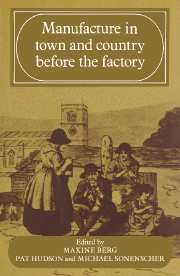Book contents
- Frontmatter
- Contents
- List of illustrations
- Acknowledgements
- 1 Manufacture in town and country before the factory
- 2 Political economy and the principles of manufacture 1700–1800
- PART I THE STRUCTURE OF MANUFACTURE
- 3 Variations in industrial structure in pre-industrial Languedoc
- 4 Seasonal fluctuations and social division of labour: rural linen production in the Osnabrück and Bielefeld regions and the urban woollen industry in the Niederlausitz, c. 1770–c. 1850
- 5 From manor to mill: the West Riding in transition
- PART II ‘WORK’ AND ‘WAGES’
- Appendix 1 Norwich embezzlement convictions in the eighteenth century: problems of evidence
- Appendix 2 Estimates of the size of the supplement to wages available through embezzlement in two eighteenth-century industries
- Appendix 3 Statutes concerned with embezzlement in the putting-out industries, 1500–1800
- Index
5 - From manor to mill: the West Riding in transition
Published online by Cambridge University Press: 16 October 2009
- Frontmatter
- Contents
- List of illustrations
- Acknowledgements
- 1 Manufacture in town and country before the factory
- 2 Political economy and the principles of manufacture 1700–1800
- PART I THE STRUCTURE OF MANUFACTURE
- 3 Variations in industrial structure in pre-industrial Languedoc
- 4 Seasonal fluctuations and social division of labour: rural linen production in the Osnabrück and Bielefeld regions and the urban woollen industry in the Niederlausitz, c. 1770–c. 1850
- 5 From manor to mill: the West Riding in transition
- PART II ‘WORK’ AND ‘WAGES’
- Appendix 1 Norwich embezzlement convictions in the eighteenth century: problems of evidence
- Appendix 2 Estimates of the size of the supplement to wages available through embezzlement in two eighteenth-century industries
- Appendix 3 Statutes concerned with embezzlement in the putting-out industries, 1500–1800
- Index
Summary
There has been a strong tendency in recent literature to generalise about the nature of rural domestic industry, its emergence and its ‘role’ in the transition to industrialisation. The purpose of this essay is to examine the structure of the rural textile industry in the West Riding of Yorkshire. This region was one of the key areas of Britian's Industrial Revolution, more important than Lancashire until the late eighteenth century and second only to its neighbour as the centre of factory textiles by the second half of the nineteenth century. The different organisational forms of the rural textile industry in this region were intimately related to their agrarian setting and promoted very different types of transition to centralised production. The case of the West Riding thus demonstrates something of the difficulty and danger of presenting the phenomenon of proto-industry in terms of a general economic model.
Rural production in Western Europe by the seventeenth and eighteenth centuries encapsulated a vast variety of organisational forms, some arising directly from technological dictates, others not. At one pole were Kaufsystems of independent artisan households working on their own raw materials and producing a saleable product. Usually a small farm and dual occupation were crucial to the viability of these units. At the other extreme were found putting-out or Verlagsystems, often incorporating sophisticated division of labour between households. Here the catalyst was the merchant who put out work on various processes to an increasingly dependent, often landless, rural proletariat. Between these poles existed a broad spectrum of organisational forms with their associated mix of agriculture and industry and their different household and property structures.
- Type
- Chapter
- Information
- Manufacture in Town and Country Before the Factory , pp. 124 - 144Publisher: Cambridge University PressPrint publication year: 1983
- 18
- Cited by



